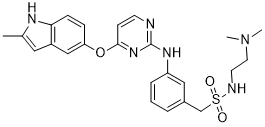This product is for research use only, not for human use. We do not sell to patients.

| Size | Price | Stock |
|---|---|---|
| 250mg | $800 | Check With Us |
| 500mg | $1350 | Check With Us |
| 1g | $2025 | Check With Us |
Cat #: V15481 CAS #: 1308672-74-3 Purity ≥ 98%
Description: Sulfatinib, formerly known as surufatinib, is an orally bioavailable, small molecule inhibitor of vascular endothelial growth factor receptors (VEGFR) 1, 2, and 3, and the fibroblast growth factor receptor type 1 (FGFR1), with potential antineoplastic and anti-angiogenic activities.
References: PCT Int. Appl. (2011), WO 2011060746 A1 20110526.
Publications Citing InvivoChem Products
Product Promise

- Physicochemical and Storage Information
- Protocol
- Related Biological Data
- Stock Solution Preparation
- Quality Control Documentation
| Molecular Weight (MW) | 480.58 |
|---|---|
| Molecular Formula | C24H28N6O3S |
| CAS No. | 1308672-74-3 |
| SMILES Code | CC1=CC2=C(N1)C=CC(OC3=NC(NC4=CC(CS(NCCN(C)C)(=O)=O)=CC=C4)=NC=C3)=C2 |
| Synonyms | HMPL012; HMPL012; HMPL 012; Sulfatinib; surufatinib; |
| Protocol | In Vitro | Sulfatinib inhibits VEGFR1, 2, and 3, FGFR1 and CSF1R kinases with IC50s in a range of 1 to 24 nM, and it strongly blocks VEGF induced VEGFR2 phosphorylation in HEK293KDR cells and CSF1 stimulated CSF1R phosphorylation in RAW264.7 cells with IC50 of 2 and 79 nM, respectively. Sulfatinib also attenuates VEGF or FGF stimulated HUVEC cells proliferation with IC50< 50 nM. |
|---|---|---|
| In Vivo | In animal studies, a single oral dosing of Sulfatinib inhibits VEGF stimulated VEGFR2 phosphorylation in lung tissues of nude mice in an exposure-dependent manner. Furthermore, elevation of FGF23 levels in plasma 24 hours post dosing suggests suppression of FGFR signaling. Sulfatinib demonstrates potent tumor growth inhibition in multiple human xenograft models and decreases CD31 expression remarkably, suggesting strong inhibition on angiogenesis through VEGFR and FGFR signaling. In a syngeneic murine colon cancer model CT-26, Sulfatinib demonstrates moderate tumor growth inhibition after single agent treatment[1]. After oral dosing of 10 mg/kg, the AUC and Cmax are 397 ng/mL and 138ng/mL in the mouse, respectively. |
| Solvent volume to be added | Mass (the weight of a compound) | |||
|---|---|---|---|---|
| Mother liquor concentration | 1mg | 5mg | 10mg | 20mg |
| 1mM | 2.0808 mL | 10.4041 mL | 20.8082 mL | 41.6164 mL |
| 5mM | 0.4162 mL | 2.0808 mL | 4.1616 mL | 8.3233 mL |
| 10mM | 0.2081 mL | 1.0404 mL | 2.0808 mL | 4.1616 mL |
| 20mM | 0.1040 mL | 0.5202 mL | 1.0404 mL | 2.0808 mL |
This equation is commonly abbreviated as: C1 V1 = C2 V2
- (1) Please be sure that the solution is clear before the addition of next solvent. Dissolution methods like vortex, ultrasound or warming and heat may be used to aid dissolving.
- (2) Be sure to add the solvent(s) in order.




































